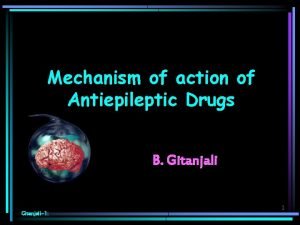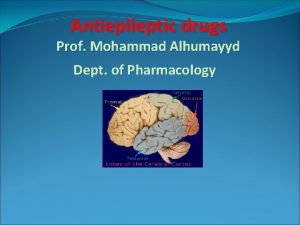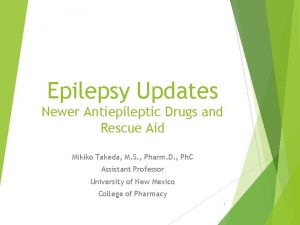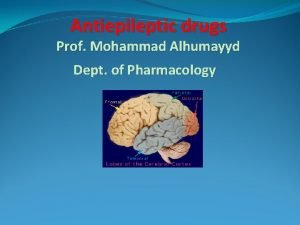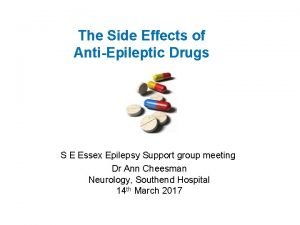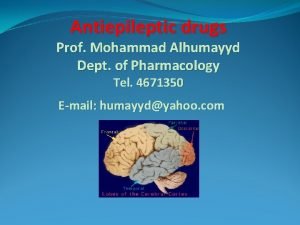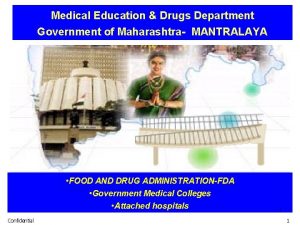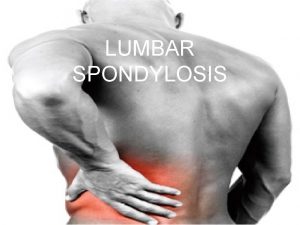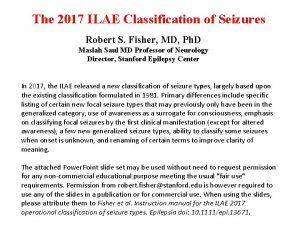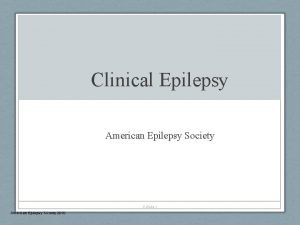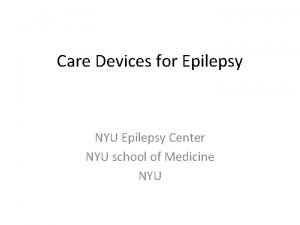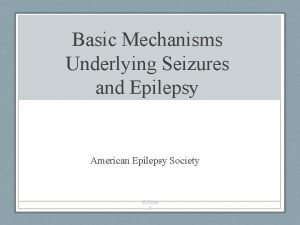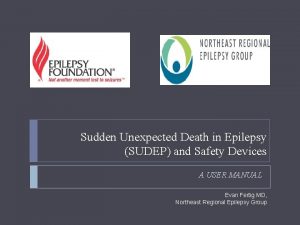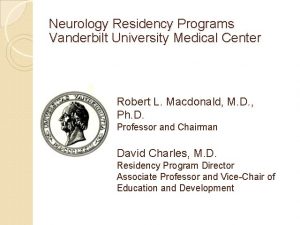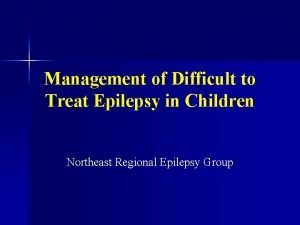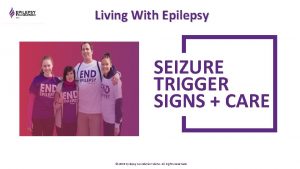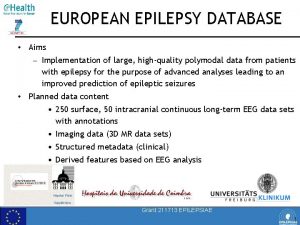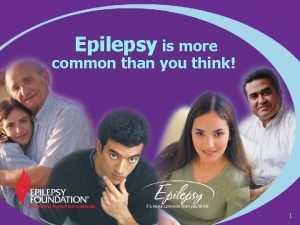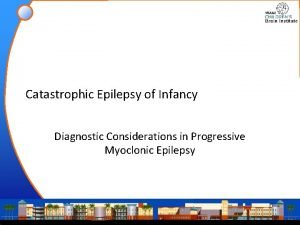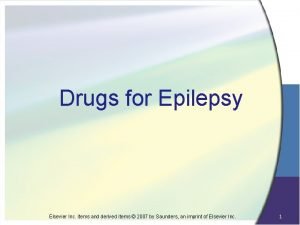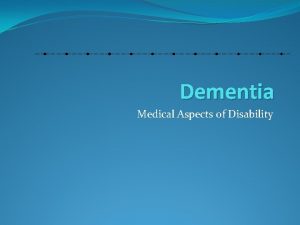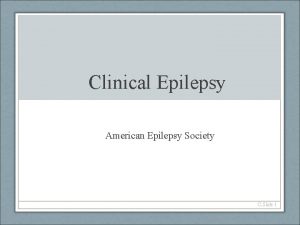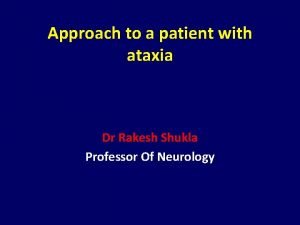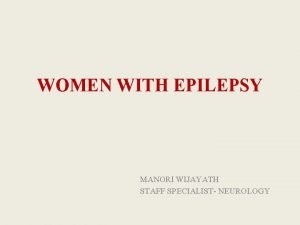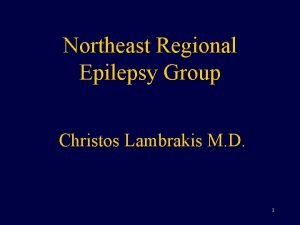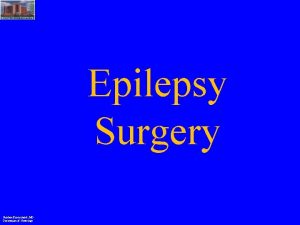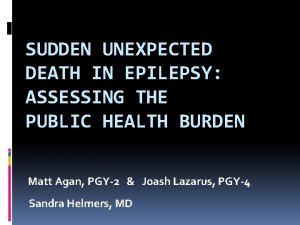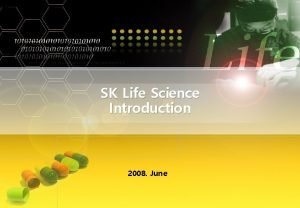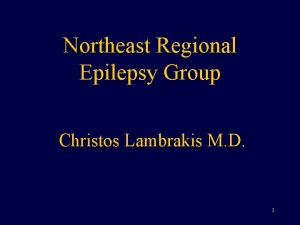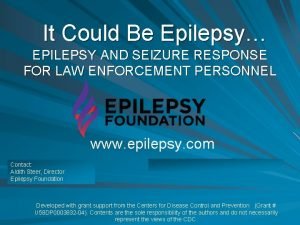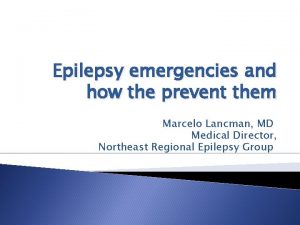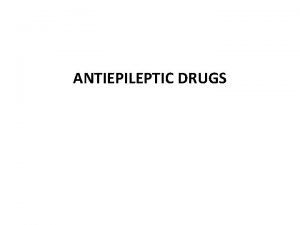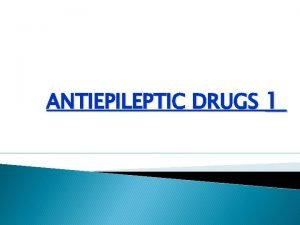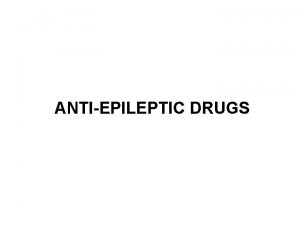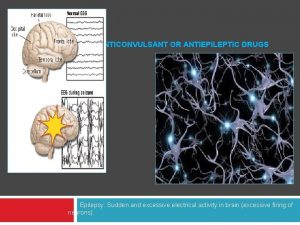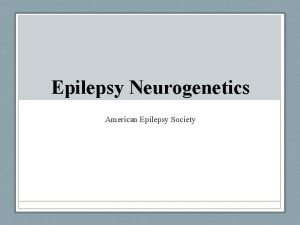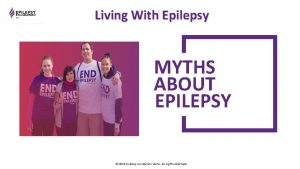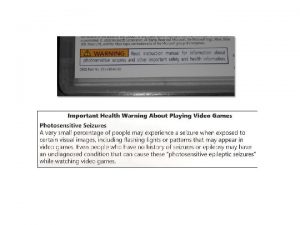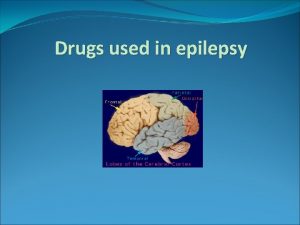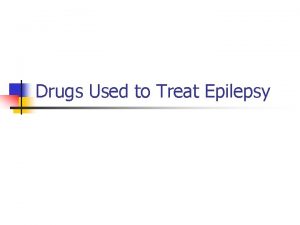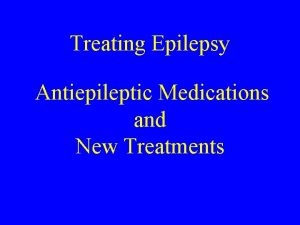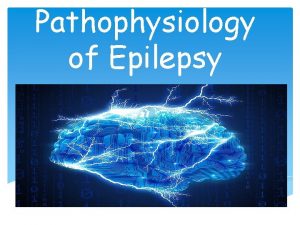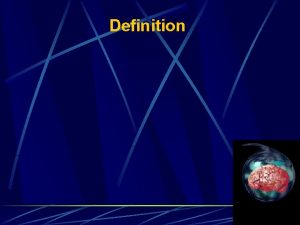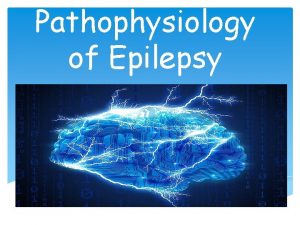Antiepileptic drugs Definition Epilepsy is a chronic medical







![Partial Arise in one cerebral hemisphere [1] Simple (consciousness is Features depend on part Partial Arise in one cerebral hemisphere [1] Simple (consciousness is Features depend on part](https://slidetodoc.com/presentation_image/2ed5ad11af056841c5f44020f2bc8b1c/image-8.jpg)




































- Slides: 44

Antiepileptic drugs

Definition • Epilepsy is a chronic medical condition characterized by 2 or more unprovoked seizures. • It is not a disease, it is a syndrome ( what is the difference ).

Seizure


Etiology Idiopathic Symptomatic Inherited abnormality in the C. N. S. Tumors Head injury Hypoglycemia Meningeal infections Drug withdrawal Photo epilepsy ( by watching TV) Fever Patients are treated chronically with antiseizure drugs or vagal nerve stimulation

Triggers Fatigue Stress Sleep deprivation Poor nutrition

Generalized: Both hemispheres + loss of consciousness. Stiffness (15 -30 sec) followed by violent Tonic-clonic contractions & relaxation (1 -2 minute) (Grand mal) Absence (Petit mal) Brief loss of consciousness with minor muscle twitches eye blinking Myoclonic Rhythmic, jerking spasms Clonic Spasms of contraction & relaxation Tonic Muscle stiffness Atonic Sudden loss of all muscle tone
![Partial Arise in one cerebral hemisphere 1 Simple consciousness is Features depend on part Partial Arise in one cerebral hemisphere [1] Simple (consciousness is Features depend on part](https://slidetodoc.com/presentation_image/2ed5ad11af056841c5f44020f2bc8b1c/image-8.jpg)
Partial Arise in one cerebral hemisphere [1] Simple (consciousness is Features depend on part of brain affected retained) Motor (Jacksonian epilepsy) Jerking, muscle rigidity, spasms, head-turning Sensory Unusual sensations Autonomic Psychologic [2] Complex (Altered Memory or emotional disturbances Automatisms & behavioral changes consciousness) [3] Secondarily generalized seizure Begins as partial (simple or complex) and progress into grand mal seizure


Tonic-clonic (grand mal) seizures

Absence seizures brief; loss of consciousness accompanied by minimal motor manifestations cessation of an ongoing behavior full recovery is evident after 5 -15 sec.

Partial seizures Simple consciousness is often preserved. (e. g. deviation of the head & eyes to one side) Complex loss of awareness or contact with the environment, often associated with behavioral or complex motor movements for which the patient is amnesic after the attacks

General rules for treatment of epilepsy Antiepileptic drugs suppress but not cure seizures Antiepileptic drugs are indicated when there is two or more seizures occurred in short interval ( 6 m-1 y) An initial therapeutic aim is to use only one drug (monotherapy).

Drugs are usually administered orally Monitoring plasma drug level is useful Triggering factors can affect seizure control by drugs. Sudden withdrawal of drugs should be avoided ( cause status epilepticus)

Withdrawal started After seizure –free period of 2 -3 from the last fit. or more years Normal neurological examination , Normal EEG Relapse rate is 20 -40%.

How Drugs Act? of Epilepsy Pathophysiology Blockade of voltage – gated channels (Na+ or Ca+) Enhancement of GABA Or interference with Glutamate transmission (citatory) (inhibitory)


Classification of antiepileptic drugs First-generation v Phenytoin Second- generation v Lamotrigine v. Carbamazepine v. Levitiracetam v. Valproate v. Topiramate

Carbamazepine Pharmacokinetics : Ø Available only orally Ø Well absorbed Ø Strong enzyme inducer including its own metabolism Ø Metabolized by the liver to active & inactive metabolites Ø Excreted in urine

Carbamazepine Mechanism of action �Blockade of Na+ channels q reduce the propagation of abnormal impulses in the brain q inhibit the generation of repetitive action potential �Inhibit the release of glutamate Therapeutic uses: �Drug of choice in partial seizures. �Tonic-clonic seizures (1 ry & 2 ry generalized) but Not in absence seizures. �Neuropathic pain �Mood stabilizer

Side effects �GIT upset. �Hypersensitivity reactions �Drowziness , ataxia, headache & diplopia �Blood dyscrasis �Hyponatremia & water intoxication �Teratogenicity ( neural tube defects ). �Induction of hepatic P 450

Phenytoin Pharmacokinetics : v Well absorbed orally, it is also available as iv. (for emergency ) v Enzyme inducer v Metabolized by the liver to inactive metabolites v Excreted in urine

Phenytoin Mechanism of action �Blockade of Na+ channels. �Interfere with the release of excitatory transmitters �Potentiate the action of GABA Therapeutic uses: �Partial and generalized tonic-clonic seizures Not in absence seizure. �In status epilepticus, IV. �Cardiac arrhythmias

Side effects A ) dose-related : �Nausea or vomiting �Neurological like : headache, vertigo, ataxia, diplopia , nystagmus �Sedation

B) Non –dose related Gum hyperplasia Coarsening of facial features Hirsutism Acne Megaloblastic anemia Osteomalcia Teratogenic effect Enzyme inducer

Sodium Valproate Broad spectrum antiepileptic Pharmacokinetics : o Available as capsules, Syrup Metabolized by the liver ( inactive ) o Enzyme inhibitor o Excreted in urine

Sodium valproate Mechanism of action � Blockade of Na+ channels. � Inhibits GABA transaminase � Suppress glutamate action. � Blocks T-type Ca 2+ channels [II] Other uses: • Bipolar disorder • Prophylaxis of migraine • Lennox-Gastaut syndrome Therapeutic Uses [I] Epilepsy: It is effective for all forms of epilepsy e. g. � Generalized tonic-clonic seizures (1 ry or 2 ry ). � Absence seizures � Complex partial seizures � Myoclonic � Atonic � photosensitive epilepsy

Sodium Valporate Drug of choice in patients have concomitant generalized tonic-clonic seizures and absence seizures

Side effects: Ø Ø Weight gain ( appetite ). Transient hair loss, with re-growth of curly hair Ø Ø Thrombocytopenia Hepatotoxicity Teratogenicity ( spina bifida) Enzyme inhibitor of P -450

Lamotrigine Mechanism of action �Blockade of Na+ channels �Inhibits excitatory amino acid release ( glutamate & aspartate ) �Inhibitory action on voltage activated Ca++ channels Therapeutic Use �As add-on therapy in refractory complex partial seizure or as monotherapy in generalized seizures including absence seizure �Myoclonic seizures in children �Lennox-Gastaut syndrome

Side effects Influenza-like symptoms. Skin rashes (may progress to Steven –Johnson syndrome ) Somnolence Blurred vision Diplopia Ataxia

Levetiracetam Pharmacokinetics : Ø Taken orally ( tablets or solutions) Ø Not metabolized & excreted unchanged in urine Ø Ø Does not affect liver enzymes Drug interactions are minimal

Levetiracetam Mechanism of action Unknown Therapeutic Uses Adjunctive therapy in : �Partial seizures �Generalized tonic-clonic seizures Monotherapy • Myoclonic seizures

Side effects Ataxia Dizziness Somnolence Pin & needles sensation in extremities Blurred vision

Topiramate Rapidly absorbed Half-life 2 hours Linear metabolism in liver Excreted by kidney

Clinical Uses Has a broad spectrum of activity As adjunctive therapy in adult & pediatric patients with refractory partial seizures. Monotherapy in generalized tonic-clonic seizures In patients with LGS

Adverse effects Somnolence Dizziness Confusion Ataxia Diplopia Weight loss Nephrolithiasis

Other antiepileptics Old: �Phenobarbital and Primidone �Benzodiazepines (e. g. Diazepam and Lorazepam) �New antiepileptics for adjunctive treatment: �Gabapentin, vigabatrin, Felbamate, topiramate and others

Type of seizure Choice among drugs Partial seizures: Carbamazepine or phenytoin or valproate or lamotrigine. Generalised seizures: Tonic-clonic (grand mal) Valproate or carbamazepine or phenytoin or lamotrigine Myoclonic Valproate, clonazepam Absence Ethosuximide or valproate Atonic Valproate

Drugs used for treatment of Status Epilepticus �Most seizures stop within 5 minutes. When seizures follow one another without recovery of consciousness, it is called “status epilepticus”. It has a high mortality rate. Death is from cardiorespiratory failure.

Intravenous Injection of : �Lorazepam is the drug of choice �Diazepam � Phenytoin � fosphenytoin � phenobarbital.

Vagal nerve stimulation It is an alternative for patients who have been refractory to multiple drugs. Who are sensitive to the many adverse effects of antiseizure drugs It is an expensive procedure


Pregnancy & antiepileptic medications NO antiepileptic drug is safe in pregnancy. Patient has to continue therapy using the least therapeutic doses & least teratogenic drug. If follow up of pregnancy reveals teratogenic effect, terminate pregnancy.
 Ethosuximide mechanism of action
Ethosuximide mechanism of action Antiepileptic drugs classification
Antiepileptic drugs classification Antiepileptic drugs abbreviation
Antiepileptic drugs abbreviation Antiepileptic drugs classification
Antiepileptic drugs classification Antiepileptic side effects
Antiepileptic side effects Antiepileptic side effects
Antiepileptic side effects Antiepileptic drug classification
Antiepileptic drug classification Medical education and drugs department
Medical education and drugs department Definition of chronic toxicity
Definition of chronic toxicity Chronic care model definition
Chronic care model definition Definition of chronic toxicity
Definition of chronic toxicity Chronic pain definition
Chronic pain definition Epilepsy ilae 2017
Epilepsy ilae 2017 Seizure vs epilepsy
Seizure vs epilepsy Canadian league against epilepsy
Canadian league against epilepsy Migraine aura vs seizure aura
Migraine aura vs seizure aura Inflatable helmet for epilepsy
Inflatable helmet for epilepsy Basic mechanisms underlying seizures and epilepsy
Basic mechanisms underlying seizures and epilepsy Emfit epilepsy alarm manual
Emfit epilepsy alarm manual Vanderbilt neurology residents
Vanderbilt neurology residents Epilepsy
Epilepsy Epilepsy trigger
Epilepsy trigger Epilepsy and seizure services near walnut creek
Epilepsy and seizure services near walnut creek European epilepsy database
European epilepsy database Difference between seizure and epilepsy
Difference between seizure and epilepsy Catastrophic epilepsy infancy
Catastrophic epilepsy infancy Post-ictal
Post-ictal Cps epilepsy
Cps epilepsy Epilepsy foundation eau claire wi
Epilepsy foundation eau claire wi Epilepsy
Epilepsy Lamictal memory loss
Lamictal memory loss Epilepsy
Epilepsy Epilepsy
Epilepsy Antigliadin antibodies
Antigliadin antibodies Lscs post operative care ppt
Lscs post operative care ppt Northeast regional epilepsy
Northeast regional epilepsy Ne regional epilepsy group
Ne regional epilepsy group Epilepsy
Epilepsy Epilepsy death
Epilepsy death Benign rolandic epilepsy icd 10
Benign rolandic epilepsy icd 10 Ykp epilepsy
Ykp epilepsy Epilepsy ppt
Epilepsy ppt Xl spikes on eeg
Xl spikes on eeg Seizures
Seizures Aremco epilepsy
Aremco epilepsy
